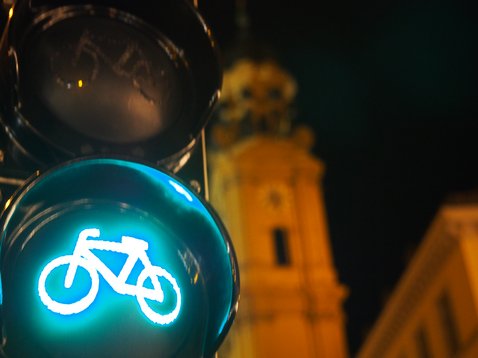RASCH
RAdSCHnellwege: Gestaltung effizienter und sicherer Infrastruktur

Project Description
Bicycle highways offer great potential for a direct and safe guidance of bicycle traffic across longer distances. In the paper "Einsatz und Gestaltung von Radschnellverbindungen" by FGSV bicycle highways are defined as follows (translated): "Bicycle highways are connections in the bicycle road network of a municipality or an urban region that connect important origins and destinations with a high potential across long distances and allow for a continuous safe and attractive ride with high speeds."
The goal of RASCH is to analyse the traffic properties of bicycle traffic flows on bicycle highways and the connections of bicycle highways and the remaining road network. Special focus is put on the heterogeneous composition of bicycle traffic and its influence on traffic flow. Based on these findings, new traffic control methods and intelligent transportation systems (ITS) are presented, tested and evaluated in a simulation laboratory which included a bicycle simulator. The influence of these measures on bicycle efficiency is evaluated to draw conclusions about the effect on the attractiveness. To evaluate safety effects, surrogate safety measures are taken into account.
RASCH starts of with in depth preparational work. First, the state of the art is researched and the development of future scenarios regarding the bicycle traffic composition is performed. Subsequently, thesimulation studies are prepared to analyse bicycle traffic on bicycle highways. The preparation includes the technical improvement of the bicycle simulator under consideration of the evaluation goal, the modelling of the pilot route in Munich in microscopic traffic flow simulation and an extension of this simulation with three dimensional elements such as buildings and trees in order to improve the imersion of test riders. After the preparation phase, the simulation studies are organized and performed. With the bicycle simulator and a number of test riders the behavior is researched. The main focus lies on the interaction with other road users and traffic infrastructure. In a complementary way, the developed future scenarios and traffic control methods are evaluated within microscopic traffic flow simulation. The resulting data of the simulation studies regarding both safety and efficiency will be statistically analysed and evaluated.
Lastly, the knowledge gained in the project will be prepared and summarized. The results regarding the traffic flow on bicycle highways, the signalization and signage as well as the connection with the remaining road network will be presented in form of publicly available guidelines. Furthermore, the technical and experimental experience gained with the bicycle simulator are presented in a separate report. In this way, recomendations regarding the usage and the possible applications of bicycle simulators can be given.
| Keywords | Bicycle Highway, Bicycle Simulator |
| Funding | Federal Ministry of Transport and Digital Infrastructure |
| Duration | July 2017 until December 2018 |
| Contact | Dr. rer. nat. Andreas Keler, Georgios Grigoropoulos, Dr.-Ing. Heather Kaths, Dr.-Ing. Matthias Spangler |
| Further information | NRVP-Projekte |